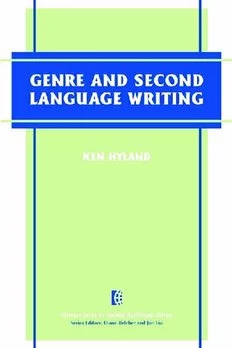
Genre and Second Language Writing PDF
Preview Genre and Second Language Writing
Genre and Second Language Writing Series Editors Diane Belcher (Georgia State University) and Jun Liu(University of Arizona) Available titles in the series Peer Response in Second Language Writing Classrooms Jun Liu & Jette G. Hansen Treatment of Error in Second Language Student Writing Dana R. Ferris Critical Academic Writing and Multilingual Students A. Suresh Canagarajah Controversies in Second Language Writing: Dilemmas and Decisions in Research and Instruction Christine Pearson Casanave Connecting Reading and Writing in Second Language Writing Instruction Alan Hirvela Genre and Second Language Writing Ken Hyland Genre and Second Language Writing Ken Hyland University of London Ann Arbor The presentations of tables, figures, and/or images are dependent on the device and display options. Some image content or language characters may have been removed or may be altered depending on the device used to read this eBook. Copyright © by the University of Michigan Press 2004 All rights reserved Published in the United States of America by The University of Michigan Press Manufactured in the United States of America ∞ Printed on acid-free paper 2007 2006 2005 2004 4 3 2 1 No part of this publication may be reproduced, stored in a retrieval system, or transmitted in any form or by any means, electronic, mechanical, or otherwise, without the written permission of the publisher. A CIP catalog record for this book is available from the British Library Library of Congress Cataloging-in-Publication Data Hyland, Ken. Genre and second language writing / Ken Hyland. p. cm. — (Michigan series on teaching multilingual writers) Includes bibliographical references and index. ISBN 0-472-03014-0 (pbk. : alk. paper) 1. Rhetoric—Study and teaching. I. Title. II. Series. P53.27H948 2004 808′.042′071—dc22 2004053687 ISBN-13 978-0-472-03014-9 (paperback) ISBN-13 978-0-472-02976-1 (electronic) Acknowledgments This book results from a sustained interest in genre that owes a great deal to the many excellent colleagues and friends who have shared their ideas and texts with me over many years. Among these I am particularly indebted to Sue Hood, Bev Derewianka, Susan Feez, and Jim Martin in Australia, to John Swales and Ann Johns in the United States, and to Chris Can- dlin and Vijay Bhatia in Hong Kong. Their varied influence is obvious on every page of this text, and I hope they find some- thing in it they can all agree with. I am also grateful to Diane Belcher and Jun Liu for coming up with the idea for this se- ries and for asking me to contribute to it and to my research assistant, Polly Tse, for sweet biscuits and sympathy during the ups and downs of writing. Finally, my thanks go to my wife, Fiona, whose love, encouragement, and conversations about writing enormously enrich my life and my work. Grateful acknowledgment is made to the following authors, publishers, and journals for permission to reprint previously published materials. Michael Barlow, Athelstan, for a screenshot from “MonoConc Pro.” Butterworth-Heinemann for “Letter to the Editor,” from The Laurie Taylor Guide to Higher Education, by L. Taylor, copy- right © 1994. Reprinted by permission of Butterworth-Heine- mann. Cambridge University Press for adapted Figure 3.2 and Figure 5.2 from Second Language Writing, by K. Hyland, copyright © 2003. Reprinted with the permission of Cambridge Univer- sity Press. vi Acknowledgments Elsevier for “A Genre-Based Approach to the Teaching of Re- port Writing,” pp. 1–13 (Appendix pp. 11–13) of English for Specific Purposes, vol. 10, by S. Marshall, copyright © 1991. Reprinted with permission from Elsevier. Peter Knapp for figure from p. 152 of Context—Text—Gram- mar: Teaching the Genres and Grammar of School Writing in Infants and Primary Classrooms,by P. Knapp and M. Watkins, copyright © 1994. John Milton, Copulang, for a screenshot from “WordPilot 2000.” National Centre for English Language Teaching and Research (NCELTR), Macquarie University, Australia, for the following figures: “Deisigning a Course,” p. 79, from Focus on Speaking, by A. Burns and H. Joyce, copyright © 1997. “Description of a Narrative Structure,” pp. 225–26, from Using Functional Grammar: An Explorer’s Guide, 2nd ed., by D. Butt, R. Fahey, S. Feez, S. Spinks, and C. Yallop, copy- right © 2000. “Teacher-Learner Collaboration,” p. 27; “Teaching Learn- ing Cycle,” p. 28; “Assessment Checklist,” p. 131; “Sample Analysis of Learner Descriptive Text,” pp. 132–34; and “Objectives,” p. 134, from Text-Based Syllabus Design, by S. Feez, copyright © 1998. NSW Adult Migrant English Services, Australia, for excerpts from CSWE test materials, copyright © 1987. Routledge for figures from p. 126, and pp. 128–29 of Extend- ing Literacy: Children Reading and Writing Non-Fiction,by D. Wray and M. Lewis, copyright © 1997. Mike Scott, Liverpool University, for a screenshot from “WordSmith Tools.” The University of Michigan Press for material from English in Today’s Research World: A Writing Guide,by J. Swales and C. Feak, copyright © 2000. Acknowledgments vii The University of Michigan Press for a figure from Genre and the Language Learning Classroom, by B. Paltridge, copyright © 2001. Every effort has been made to contact the copyright holders for permission to reprint borrowed material. We regret any oversights that may have occurred and will rectify them in future printings of this book. Contents Series Foreword by Diane Belcher and Jun Liu xiii Introduction 1 1. Why Genre? 4 Genre-Based Writing Teaching 5 Why Genre Is Gaining Attention in L2 Writing Instruction 6 Advantages of Genre-Based Writing Instruction 10 Reservations about Genre Instruction 16 Genre-Process Connections 20 Summary 21 2. Perspectives on Genre 24 Approaches to Genre 24 Genre as Social Purpose: Systemic Functional Linguistics 25 Genre as Situated Action: The New Rhetoric 35 Genre as Professional Competence: English for Specific Purposes 43 Summary 50 3. Genre Knowledge 54 What Is Genre Knowledge? 54 Genre Knowledge and Schema 55 Knowledge of Shared Communicative Purposes 57 Knowledge of Text Conventions 63 Knowledge of Content and Register 72
